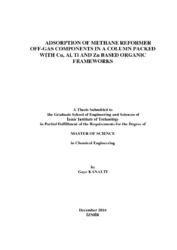Please use this identifier to cite or link to this item:
https://hdl.handle.net/11147/5725| Title: | Adsorption of Methane Reformer Off-Gas Components in a Column Packed With Cu, Al,ti and Zn Based Organic Frameworks | Other Titles: | Metan Reformer Çıkış Gazı Bileşenlerinin Cu, Al, Ti, ve Zn Temelli Organik Kafes Yapıları ile Dolgulu Kolonda Adsorpsiyonu | Authors: | Kanaltı, Gaye | Advisors: | Çakıcıoğlu Özkan, Seher Fehime | Keywords: | Stream methane reformer CO2 emissions Adsorption Metal organic framework Gas separation |
Publisher: | Izmir Institute of Technology | Source: | Kanaltı, G. (2016). Adsorption of methane reformer off-gas components in a column packed with Cu, Al,Ti and Zn based organic frameworks. Unpublished master's thesis, Izmir Institute of Technology, Izmir, Turkey | Abstract: | Within the past decade, CO2 emissions from fossil fueled power plants has accelerated rapidly as a result of the increase in energy consumption associated with industrial development all over the world. Beyond the necessity of reduction in CO2 emissions, concerning on the crude oil reserves depletion induced the urgent need of transition to more efficient, renewable, cleaner and cheaper fuel, hydrogen. In the world, most of the hydrogen is produced by hydrogen-rich stream methane reformer (SMR) off gas streams composed of 80-60% H2, 15-25% CO2, 3-6% CH4 and 1-3% CO, thereby separation of SMR components became more of an issue. In this study, adsorption based separation of SMR components were investigated in a column packed with copper (CuTPA, (SLang: 776 m2g-1)), aluminum (AlTPA, (SLang: 1330 m2g-1)), titanium (TiTPA, (SLang: 1835 m2g-1)) and zinc (ZnTPA, (SLang: 1023 m2g-1)) based organic frameworks (MOFs). The pure gas adsorption studies on equimolar CO2/H2, CH4/H2 and CO/H2 systems and the equimolar mixture of CO2/CH4 system were carried out and the experimental breakthrough curves were obtained at three different feed flow rates (10, 20 and 30 mL/min) at three column pressure (1, 5 and 10 bar) at 303 K. The highest adsorption capacities of all MOFs were achieved at 30 mL/min of feed rate and 10 bar operating pressure, at these conditions the non-adsorptive behavior of hydrogen on the aforementioned MOFs was ensured. The amounts of CO2 adsorbed were calculated as 1.61, 5.54, 5.20 and 2.11 mmolCO2/g, while adsorbed CH4 amounts were 1.50, 3.16, 3.25 and 1.90 mmol CH4/g and the adsorbed CO amounts were 1.47, 2.59, 1.91 and 1.83 mmol CO/g on CuTPA, AlTPA, TiTPA and ZnTPA, respectively. The highest selectivity for CO2 over CH4 was attained on TiTPA as 8.0 at 10 mL/min feed rate of CO2/CH4 mixture at atmospheric column pressure and 303 K. The experimental adsorption isotherms of SMR components were fitted well with Langmuir and virial models and the best fitted model parameters were evaluated for each MOF. Son on yıl içinde, enerji santrallerinden salınan CO2 miktarı endüstriyel gelişmelere bağlı olarak artan enerji tüketiminin sonucunda dünya çapında hızla yükselmiştir. CO2 salınımın azaltılması gerekliliğinin yanı sıra, ham petrol kaynaklarındaki düşüş daha verimli, temiz ve ucuz yenilenebilir yakıt olan hidrojene geçişi zorunlu bir hale getirmiştir. Dünya çapında, hidrojen genellikle hidrojence zengin, 80-60% H2, 15-25% CO2, 3-6% CH4 ve 1-3% CO oranlarındaki metan reformer (SMR) çıkış gazı akımlarından üretilmektedir, bundan dolayı SMR bileşenlerinin ayrılması önem arz etmektedir. Bu çalışmada, adsorpsiyon yöntemi ile SMR gazı bileşenlerinin ayrıştırılması bakır (CuTPA, (SLang: 776 m2g-1)), alüminyum (AlTPA, (SLang: 1330 m2g-1)), titanyum (TiTPA, (SLang: 1835 m2g-1)) ve çinko temelli organik kafes yapıları (MOFs) ile doldurulmuş kolonda incelenmiştir. Saf bileşen adsorpsiyon çalışmaları eş molar CO2/H2, CH4/H2 ve CO/H2 sistemleri üzerinde ve ikili gaz karışım çalışmaları CO2/CH4 sistemi üzerinde üç farklı besleme hızında (10, 20 ve 30 mL/dk) ve üç farklı kolon basıncında (1, 5 ve 10 bar) ve 303 K’ de elde edilen salınım eğrileri ile gerçekleştirilmiştir. Bütün MOF’ ların en yüksek adsorplama kapasitesine 30 mL/dk besleme hızında ve 10 bar kolon basıncında ulaştığı, bu koşullarda hidrojenin sözü edilen MOF’ lar üzerinde adsorplanmadığı kesinleştirilmiştir. CuTPA, AlTPA, TiTPA ve ZnTPA tarafından adsorplanan CO2 miktarları sırasıyla 1.61, 5.54, 5.20 ve 2.11 mmolCO2/g olarak hesaplanırken, CH4 miktarları 1.50, 3.16, 3.25 ve 1.90 mmol CH4/g ve CO miktarları ise 1.47, 2.59, 1.91 ve 1.83 mmol CO/g olarak bulunmuştur. CO2’ in CH4 üzerindeki en yüksek seçimli adsorpsiyonu TiTPA üzerinde 8 olarak 10 mL/dk akış hızında atmosfer basıncında 303 K’ de ulaşılmıştır. SMR bileşenlerinin deneysel adsorpsiyon izotermleri Langmuir ve virial modellerle uyuşmuş ve en uygun model parametreleri her bir MOF için değerlendirilmiştir. |
Description: | Thesis (Master)--Izmir Institute of Technology, Chemical Engineering, Izmir, 2016 Full text release delayed at author's request until 2019.01.30 Includes bibliographical references (leaves 81-98) Text in English; Abstract: Turkish and English xiii, 129 leaves |
URI: | http://hdl.handle.net/11147/5725 |
| Appears in Collections: | Master Degree / Yüksek Lisans Tezleri |
Files in This Item:
| File | Description | Size | Format | |
|---|---|---|---|---|
| T001552.pdf | MasterThesis | 2.99 MB | Adobe PDF |  View/Open |
CORE Recommender
Items in GCRIS Repository are protected by copyright, with all rights reserved, unless otherwise indicated.